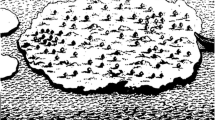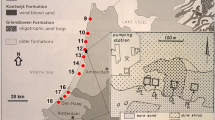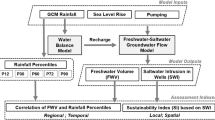Abstract
The water resources of the 32 atolls of the Federated States of Micronesia (FSM) are under continual threat from El Niño-induced droughts and other natural hazards. With government policies emphasizing sustainable development of atoll-island communities, local managers are in need of tools for predicting changes in the availability of fresh groundwater, which communities depend upon during droughts that incapacitate rain-catchment systems. An application of a recently developed, readily portable algebraic model is demonstrated here, to estimate the freshwater-lens thickness of atoll islands in the FSM, a key component of FSM groundwater resource assessment. Specifically, the model provides estimates of the lens thickness of atoll islands in the FSM during normal and drought conditions. The model was tested for use in the FSM through comparison with available lens data under both average rainfall conditions and intense drought conditions, and then applied to major islands of each atoll within the FSM. Results indicate that out of 105 major islands on FSM atolls, only six would likely retain sufficient groundwater to sustain the local community during an intense drought.
Résumé
Les ressources en eau des 32 atolls des États Fédérés de Micronésie (EFM) sont sous la menace continue des sécheresses et autres catastrophes naturelles dues à El Niño. Avec les politiques gouvernementales insistant sur le développement durable des communautés d’îles-atoll, les gestionnaires locaux ont besoin d’outils pour prévoir les changements de disponibilité de l’eau douce souterraine dont les communautés dépendent en période de sécheresse qui rend inutiles les systèmes de captage de pluie. Pour estimer l’épaisseur des lentilles d’eau d’îles-atoll du FSM, composante clef de l’évaluation de la ressource en eau des EFM, un modèle numérique transférable facile à mettre en œuvre a été récemment développé, il est présentée ici. Le modèle fournit en particulier l’estimations de l’épaisseur des lentilles d’eu douce d’atolls des EFM dans des conditions normales et de sécheresse. Pour une utilisation dans les EFM, le modèle a été testé par comparaison avec les données disponibles sur des lentilles, à la fois dans des conditions pluviométriques moyennes et de sécheresses intenses, puis appliqué aux îles principales de chaque atoll des EFM. Les résultats indiquent que, sur 105 des principales îles des atolls des EFM, vraisemblablement six seulement retiendraient suffisamment d’eau souterraine pour alimenter eau la communauté locale durant une sécheresse intense.
Resumen
Los recursos de agua de 32 atolones de los Estados Federados de Micronesia (FSM) están bajo una continua amenaza de sequías inducidas por El Niño y otros riesgos naturales. Con las políticas del gobierno que enfatizan el desarrollo sostenible de las comunidades de las islas atolones, los gestores locales necesitan herramientas para predecir cambios en la disponibilidad de agua dulce, de las cuales dependen las comunidades durante las sequías que se inhabilitan los sistema de captación de la lluvia. Se demuestra que una aplicación recientemente desarrollada de un modelo algebraico fácilmente transportable para estimar los espesores de las lentes de agua dulce de las islas atolones en los FSM, es una componente clave de la evaluación de los recursos de agua subterránea de los FSM. Específicamente, el modelo provee estimaciones del espesor de las lentes de las islas atolones en los FSM durante condiciones normales y de sequía. El modelo fue probado para el uso en los FSM a través de la comparación con datos disponibles de lentes tanto en condiciones de precipitaciones promedio como de sequías intensas, y luego aplicado a las islas principales de cada atolón dentro de los FSM. Los resultados indican que de las 105 islas principales en las islas atolones de los FSM, solo en seis casos probablemente podrían retener suficiente agua subterránea para sostener a la comunidad local durante una intensa sequía.
摘要
密克罗尼西亚联邦(FSM)的32个环礁岛的水资源持续受到厄尔尼诺现象导致的干旱和其它自然灾害的威胁。在强调环礁岛社区可持续发展的政府政策的指导之下,当地的管理人员正在寻求一种可以预测地下淡水可用性的工具,使环礁岛社区可以在降雨汇流系统失效的旱季对其加以利用。本文应用了一种近期建立起来的便携的代数模型,用来估计FSM的环礁岛中淡水透镜体的厚度,这是FSM地下水资源评价的重要组成部分。具体来说,这个模型估计了正常与干旱条件下FSM环礁岛的透镜体厚度。此模型通过在FSM应用而进行检验测试,对比了在平均降雨条件和严重的干旱条件下可用的透镜体数据,然后应用到了FSM的每个环礁岛的主要岛屿。结果表明,在FSM的105个主要岛屿中,只有6个可以在严重的干旱条件下为当地的社区提供足够的地下水源。
Resumo
Os recursos hídricos dos 32 atóis dos Estados Federados da Micronésia (EFM) estão sob ameaça contínua das secas induzidas pelo El Niño e outros desastres naturais. Com a ênfase das políticas públicas no desenvolvimento sustentável das comunidades de ilhas-atol os gestores locais têm necessidade de possuir ferramentas para prever as alterações na disponibilidade de água doce subterrânea de que dependem as comunidades durante os períodos de seca que provocam o colapso dos sistemas de captação de água da chuva. Este trabalho apresenta a aplicação de um modelo algébrico recém-desenvolvido, de fácil manuseamento, que permite estimar a espessura da lente da de água doce nas ilhas-atol dos EFM, uma componente crucial para a avaliação dos recursos hídricos subterrâneos dos EFM. Mais especificamente, o modelo fornece estimativas da espessura da lente de água doce nas ilhas-atol no FSM durante condições normais e em eventos de seca. O modelo foi testado para uso nos EFM através de comparação com os dados de lentes de água doce disponíveis para ambas condições médias de precipitação e de seca intensa, sendo posteriormente aplicado nas ilhas principais de cada atol dentro dos EFM. Os resultados indicam que, das 105 principais ilhas em atóis dos EFM apenas seis poderão provavelmente reter água subterrânea suficiente para sustentar a comunidade local durante uma seca intensa.














Similar content being viewed by others
References
Anthony SS (1996a) Hydrogeology and ground-water resources of Ngatik Island, Sapwuahfik Atoll, State of Pohnpei, Federated States of Micronesia. US Geol Surv Water Resour Invest Rep 92-4005
Anthony SS (1996b) Hydrogeology and ground-water resources of Kahlap Island, Mwoakilloa Atoll, State of Pohnpei, Federated States of Micronesia. US Geol Surv Water Resour Invest Rep 92-4005
Anthony SS (1996c) Hydrogeology and ground-water resources of Pingelap Island, Pingelap Atoll, State of Pohnpei, Federated States of Micronesia. US Geol Surv Water Resour Invest Rep 92-4005
Anthony SS (1997) Hydrogeology of selected islands of the Federated States of Micronesia. In: Vacher HL, Quinn T (eds) Geology and hydrogeology of carbonate islands. Dev Sedimentol 54:693–706
Ayers JF, Vacher HL (1986) Hydrogeology of an atoll island: a conceptual model from detailed study of a Micronesian example. Ground Water 24:2–15
Bailey RT, Jenson JW, Olsen AE (2009) Numerical modeling of atoll island hydrogeology. Ground Water 47:184–196
Bailey RT, Jenson JW, Olsen AE (2010) Estimating the ground water resources of atoll islands. Water12 2:1–27
Bryan EH Jr (1953) Check list of atolls. Atoll Res Bull 19:1–38
Chapman TG (1985) The use of water balances for water resource estimation with special reference to small islands. Bull No. 4. Pacific Regional Team. Australian Development Assistance Bureau, Canberra, Australia
Cox DC (1951) The hydrology of Arno Atoll, Marshall Islands. Atoll Res Bull 8:1–29
Dickinson WR (2004) Impacts of eustasy and hydro-eustasy on the evolution and landforms of Pacific atolls. Palaeogeogr Palaeoclimatol Palaeoecol 213:251–269
Dickinson WR (2009) Pacific atoll living: how long already and until when? GSA Today 19:4–10
Falkland AC (1994) Climate, hydrology and water resources of the Cocos (Keeling) Islands. Atoll Res Bull 400:1–23
Fetter CW (1972) Position of the saline water interface beneath oceanic islands. Water Resour Res 8:1307–1315
Griggs JE, Peterson FL (1993) Ground-water flow dynamics and development strategies at the atoll scale. Ground Water 31:209–220
Hamlin SN, Anthony SS (1987) Ground-water resources of the Laura area, Majuro Atoll, Marshall Islands. US Geol Surv Water Resour Invest Rep 87-4047
Herman ME, Wheatcraft SW (1984) Groundwater dynamics investigation of Enjebi Island, Enewetak Atoll: an interpretive computer model simulation. In: Finite Elements in Water Resources. Springer, New York, pp 133–142
Hunt CD Jr (1997) Hydrogeology of Diego Garcia. In: Vacher HL, Quinn T (eds) Geology and hydrogeology of carbonate islands. Dev Sedimentol 54, pp 909–931
Lander MA, Khosrowpanah S (2004) Rainfall climatology for Pohnpei Island, Federated States of Micronesia. Technical report No. 100. Water and Energy Research Institute, University of Guam, Guam
Meehl GA (1996) Vulnerability of freshwater resources to climate change in the tropical pacific region. Water Air Soil Pollut 92:203–213
Oberdorfer JA, Buddemeier RW (1988) Climate change: effects on reef island resources. Proc Sixth Int Coral Reef Symp. 3:523–527
Oberdorfer JA, Hogan PJ, Buddemeier RW (1990) Atoll island hydrogeology: flow and freshwater occurrence in a tidally dominated system. J Hydrol 120:327–340
Peterson FL, Gingerich SB (1995) Modeling atoll groundwater systems. In: Groundwater models for resources analysis and management. CRC, Boca Raton, FL, pp 275–292
Presley TK (2005) Effects of the 1998 drought on the freshwater lens in the Laura area, Majuro Atoll, Republic of the Marshall Islands. US Geol Surv Sci Invest Rep 2005-5098
Spennemann D (2006) Non-traditional settlement patterns and typhoon hazard on contemporary Majuro Atoll, Republic of the Marshall Islands. Transform Cultures eJ 1(2):44–63
Terry JP, Falkland AC (2009) Responses of atoll freshwater lenses to storm-surge overwash in the Northern Cook Islands. Hydrogeol J 18:227–246
Underwood MR, Peterson FL, Voss CI (1992) Groundwater lens dynamics of Atoll Islands. Water Resour Res 28:2889–2902
Urish DW (1974) Fresh water on the coral atoll island. Military Eng J429:25–27
Vacher HL (1988) Dupuit-Ghyben-Herzberg analysis of strip-island lenses. Bull Geol Soc Am 100:580–591
Vacher HL (1997) Introduction: varieties of carbonate islands and a historical perspective. In: Vacher HL, Quinn T (eds) Geology and hydrogeology of carbonate islands. Dev Sedimentol 54:1–33
van der Velde M, Javaux M, Vanclooster M, Clothier BE (2006) El Niño-Southern Oscillation determines the salinity of the freshwater lens under a coral atoll in the Pacific Ocean. Geophys Res Lett 33(L21403):1–5
Voss CI, Provost AM (2003) SUTRA, A model for saturated-unsaturated variable-density ground-water flow with solute or energy transport. US Geol Surv Water Resour Invest Rep 02-4231
Wheatcraft SW, Buddemeier RW (1981) Atoll island hydrology. Ground Water 19(3):311–320
White I, Falkland T (2009) Management of freshwater lenses on small Pacific islands. Hydrogeol J 18:227–246
Woodroffe CD, Falkland AC (1997) Geology and hydrogeology of the Cocos (Keeling) Islands. In: Vacher HL, Quinn T (eds) Geology and hydrogeology of carbonate islands. Dev Sedimentol 54:885–908
Acknowledgements
Funding for this project was provided by the Department of Interior via the Water Resources Research Institute Program of the USGS (Award No. 01HQPA0010), administered through the Water and Environmental Research Institute of the Western Pacific at the University of Guam. The content of this article does not necessarily reflect the views and policies of the Department of the Interior. We thank Stephen Anthony and Todd Presley of the USGS Pacific Islands Water Science Center for assistance in analyzing field data. We also would like to acknowledge three anonymous reviewers for their helpful comments and suggestions in improving the content of this paper.
Author information
Authors and Affiliations
Corresponding author
Appendix
Appendix
Tables 3, 4, and 5 contain parameter values of the algebraic model applied to the atoll islands within Yap, Chuuk, and Pohnpei States of the FSM, respectively, for both average rainfall and drought conditions.
Rights and permissions
About this article
Cite this article
Bailey, R.T., Jenson, J.W. & Taboroši, D. Estimating the freshwater-lens thickness of atoll islands in the Federated States of Micronesia. Hydrogeol J 21, 441–457 (2013). https://doi.org/10.1007/s10040-012-0923-6
Received:
Accepted:
Published:
Issue Date:
DOI: https://doi.org/10.1007/s10040-012-0923-6




